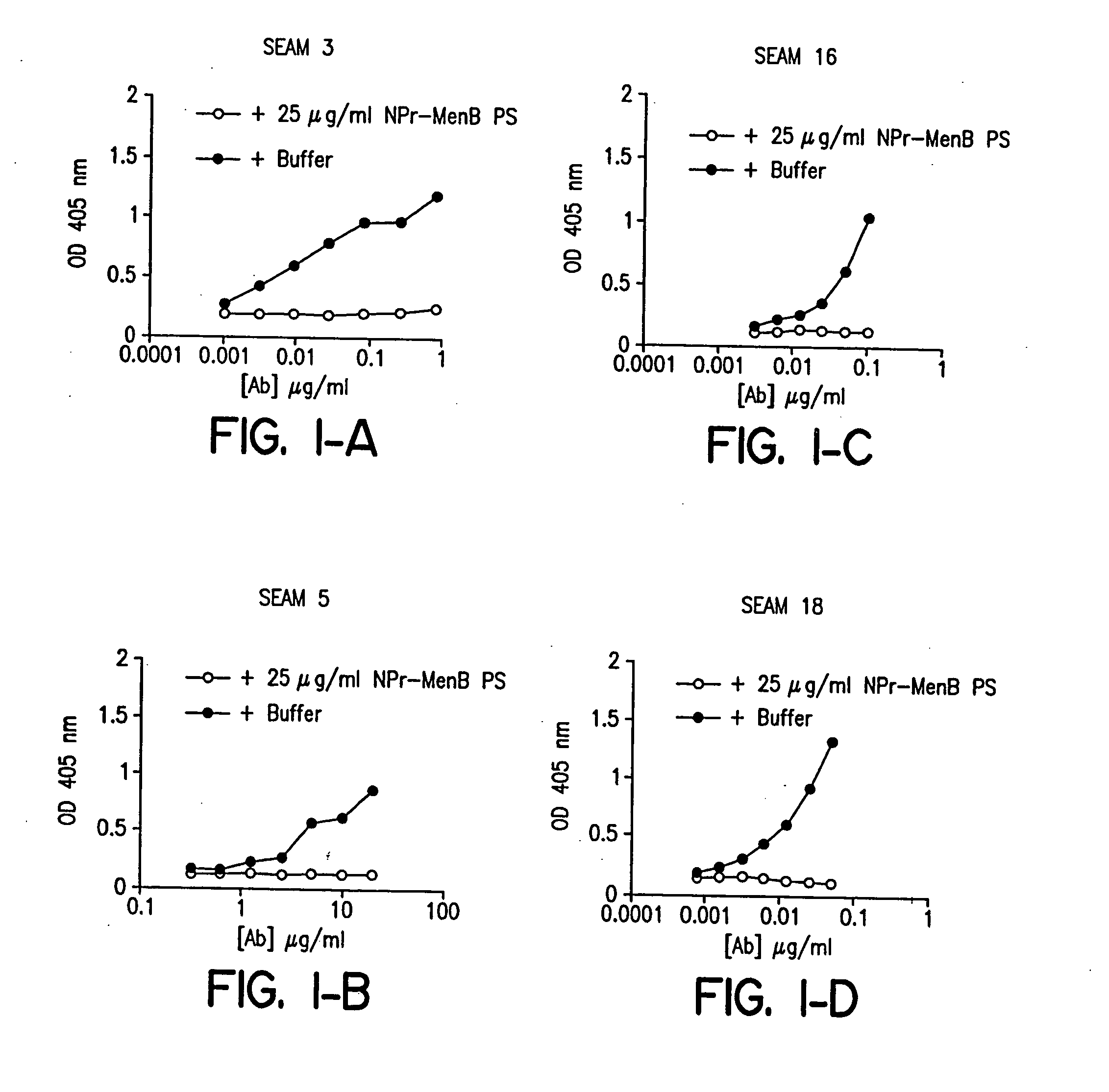Methods for isolating molecular mimetics of unique Neisseria meningitidis serogroup B epitopes
a technology of neisseria meningitidis and molecular mimetics, which is applied in the field of bacteria pathogens, can solve the problems of lack of autoreactivity of antibodies that are negative in these assays, and achieve the effect of determining autoreactivity and a safe and effective method for treatment and/or prevention
- Summary
- Abstract
- Description
- Claims
- Application Information
AI Technical Summary
Benefits of technology
Problems solved by technology
Method used
Image
Examples
example 1
Preparation of “Sized” Glycoconjugates
[0124] An exemplary NPr-MenB oligosaccharide-tetanus toxoid conjugate vaccine, hereinafter referred to as CONJ-2, was prepared as follows. The N-acetyl groups of MenB B polysaccharide were removed by heating the polysaccharide to 110° C. in 2M NaOH for 6 hours in the presence of NaBH4. The de-acetylated polysaccharide was exhaustively dialyzed in saturated sodium bicarbonate buffer then stirred with an excess of propionic anhydride for 12 hours at ambient temperature. The solution was exhaustively dialyzed in water and the N-propionylated meningococcal B (NPr-MenB PS) polysaccharide was recovered by lyophilization.
[0125] For preparation of the conjugate vaccine, the NPr-MenB polysaccharide was partially hydrolyzed in 10 mM sodium acetate at pH 5.5 at 50EC for 2 hours. The resulting mixture of oligosaccharides was fractionated on Q-SEPHAROSE (a quaternary ammonium strong anion exchanger). Oligosaccharides having an average degree of polymerizat...
example 2
Characterization of the Glycoconjugates
[0127] The CONJ-2 glycoconjugate was characterized as follows. In order to demonstrate covalence (e.g., establishing a covalent linkage between the NPr-MenB OS and the protein carrier), a number of physico-chemical techniques can be used, including: SDS-PAGE; Western Blot; SEPHADEX G-100 gel filtration; or the like. For the purposes of the present study, SDS-PAGE was used to establish covalent attachment of the NPR-MenB OS / TT CONJ-2 glycoconjugates by revealing a shift to higher molecular weight for the conjugate band as compared to the carrier protein band, per se. Western blot analysis of the CONJ-2 glycoconjugates demonstrated covalence by the coincidence of positive immunoreactive signals for TT and NPr-MenB PS with specific anti-TT and anti-NPr-MenB PS antisera.
[0128] Based on steric factors, the use of oligosaccharides instead of large molecular weight polysaccharides in the preparation of the CONJ-2 glycoconjugates allows for higher co...
example 3
Preparation of Monoclonal Antibodies
[0130] 4 to 6 week old female CD1 mice were vaccinated by ip injection using a composition containing an NPr-MenB OS / TT (CONJ-2) glycoconjugate antigen and (except for the last booster injection) FCA. Vaccinations were administered at one month intervals for a total of 2 or 3 dosages (including the booster immunization). Three days prior to fusion, the primed animals were boosted with the NPr-MenB OS / TT (CONJ-2) glycoconjugate antigen in the absence of adjuvant. The final volume of each dose was 0.1 ml, which contained 2.5 μg of sialic acid. After the booster injection, the animals were splenectomized and the spleen cells were prepared for fusion with myeloma cells.
[0131] Approximately one week before fusion, non-secreting murine P3X63-Ag8.653 myeloma cells (available from the ATCC under accession number ATCC-1580-CRL), were expanded in complete RPMI-1640 medium with 25 mM HEPES buffer and L-Glutamine (GIBCO BRL 041-02400). The cell cultures wer...
PUM
| Property | Measurement | Unit |
|---|---|---|
| Fraction | aaaaa | aaaaa |
| Fraction | aaaaa | aaaaa |
| Fraction | aaaaa | aaaaa |
Abstract
Description
Claims
Application Information
 Login to View More
Login to View More - R&D
- Intellectual Property
- Life Sciences
- Materials
- Tech Scout
- Unparalleled Data Quality
- Higher Quality Content
- 60% Fewer Hallucinations
Browse by: Latest US Patents, China's latest patents, Technical Efficacy Thesaurus, Application Domain, Technology Topic, Popular Technical Reports.
© 2025 PatSnap. All rights reserved.Legal|Privacy policy|Modern Slavery Act Transparency Statement|Sitemap|About US| Contact US: help@patsnap.com



